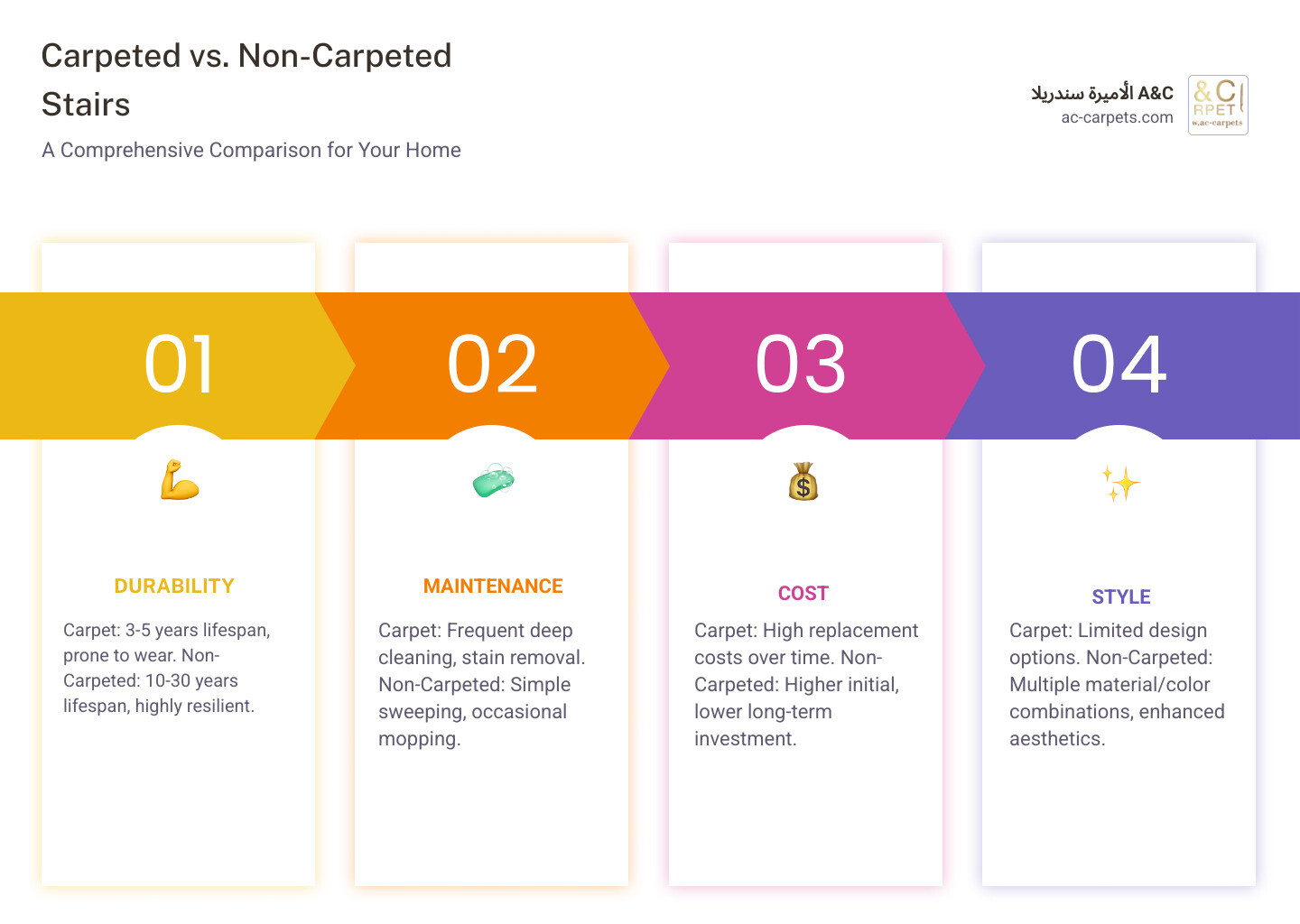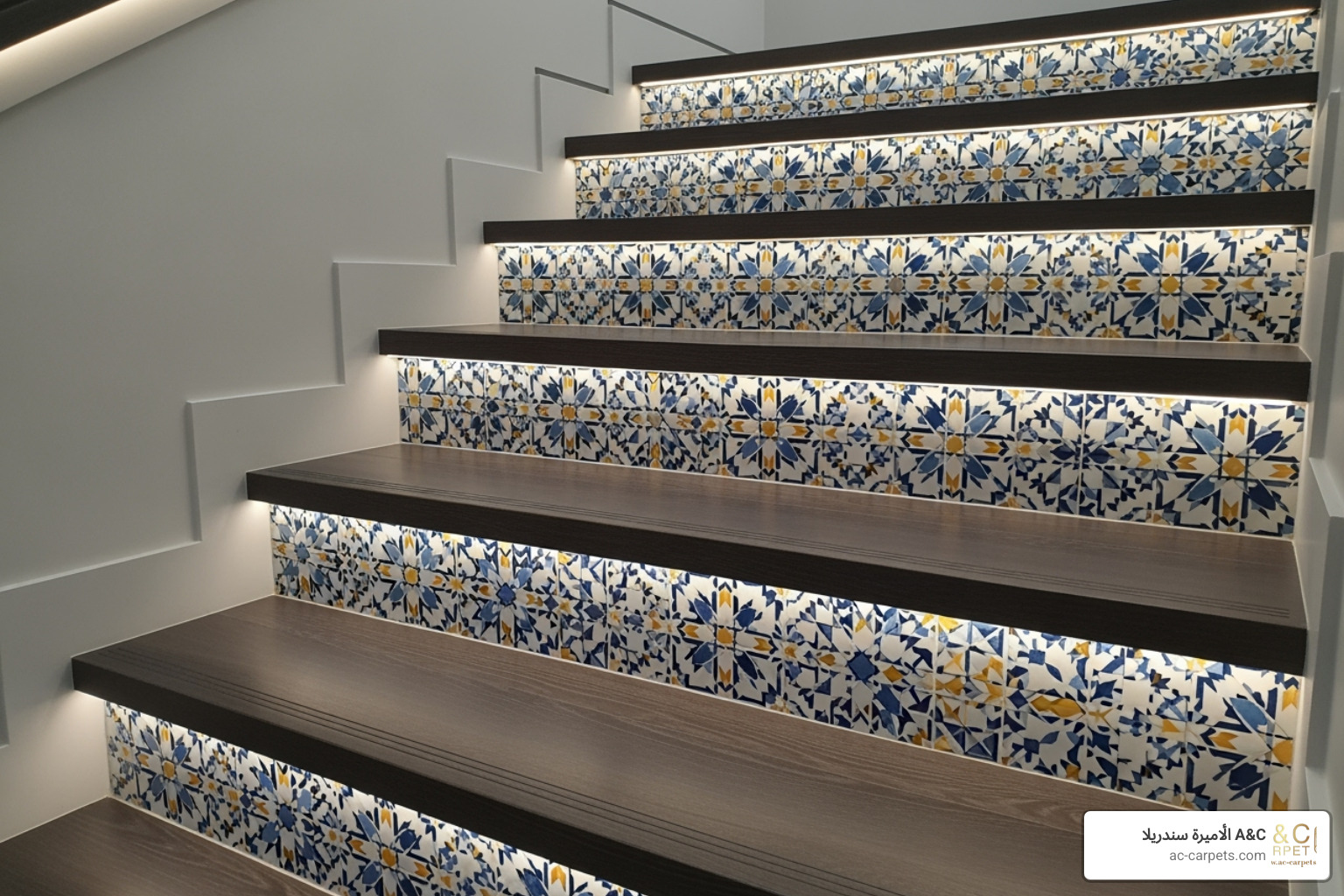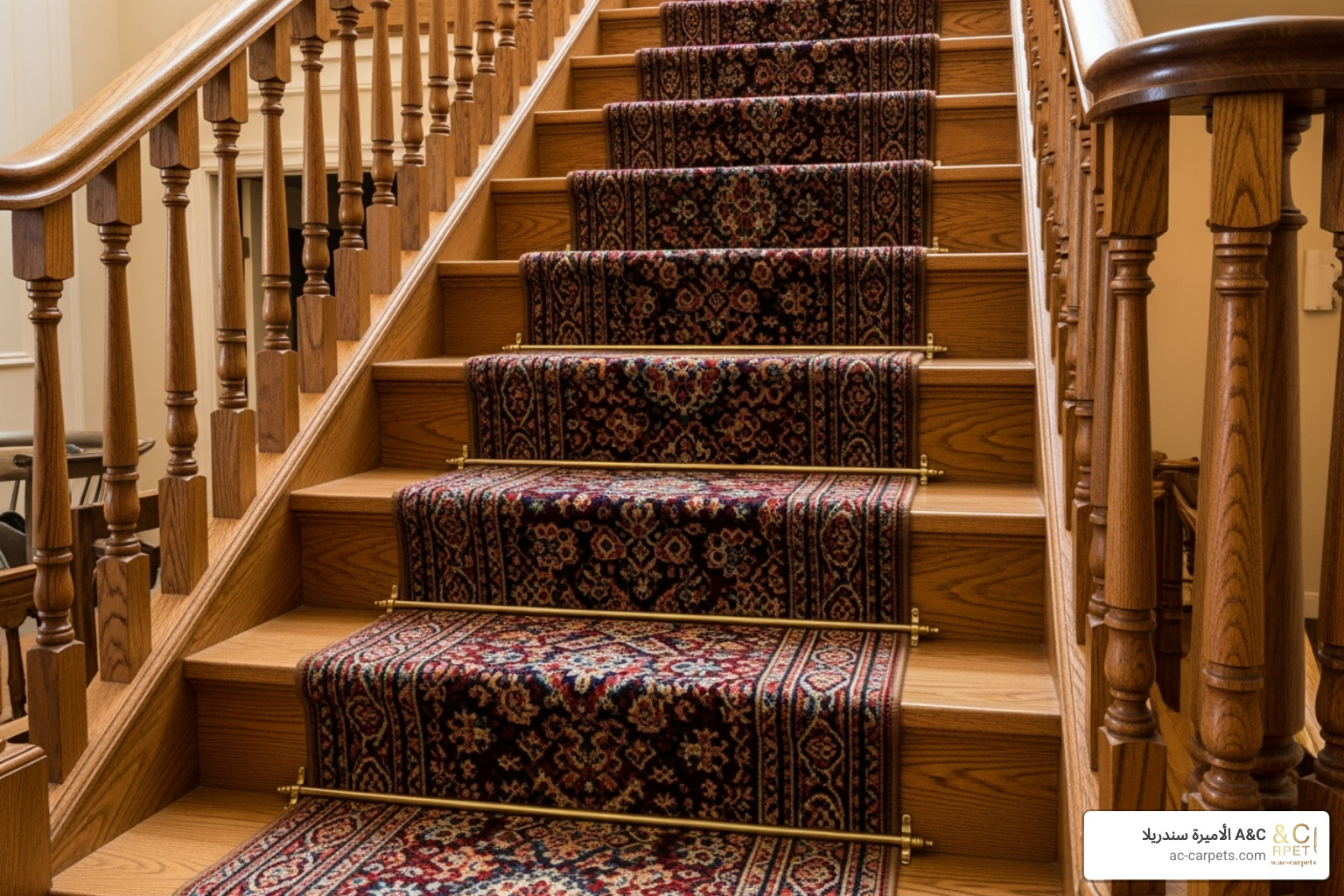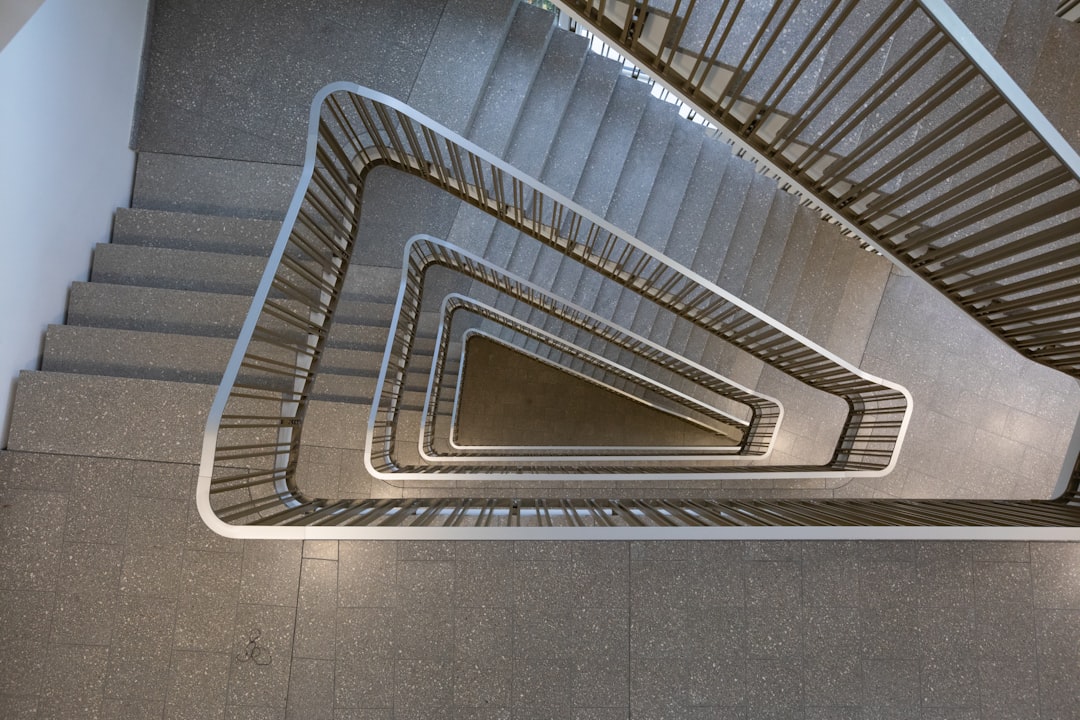Stair ideas instead of carpet: 7 Amazing Makeovers
Why Your Stairs Deserve Better Than Carpet
Stair ideas instead of carpet are becoming increasingly popular as homeowners find the hidden beauty beneath their worn, stained carpeting. As one DIY enthusiast put it: “Years ago, the carpeting on the main staircase in my home was starting to look quite worn. It always seems the steps are the first place to show wear.”
Quick Answer: Top Stair Ideas Instead of Carpet:
- Painted Wood Stairs – Budget-friendly, easy DIY project
- Stained Wood Treads – Timeless, durable, matches existing floors
- Laminate Flooring – Cost-effective, modern look (~$200 for materials)
- Tile Risers with Wood Treads – Creative, durable combination
- Stair Runners with Wood – Best of both worlds for comfort and style
- Vinyl Plank Flooring – Water-resistant, easy maintenance
Carpeted stairs face constant wear from daily foot traffic, pet damage, and spills that are nearly impossible to clean properly. The research shows that painted staircases are a practical choice that can breathe new life into tired, original treads, cover up scuffs and stains in this high-traffic space, and painted surfaces are much easier to clean than carpet.
Beyond the practical benefits, removing carpet reveals your home’s architectural character. Whether you choose bold painted risers, neat stained wood, or modern laminate, these alternatives offer better durability, easier maintenance, and improved aesthetic appeal compared to traditional carpeting.
I’m Ramy Saber, founder of الأميرة سندريلا A&C, and I’ve helped countless clients transform their spaces with innovative flooring solutions. Through years of experience in construction and facility management, I’ve seen how the right stair ideas instead of carpet can dramatically improve both the function and beauty of any space.

The Classic Refresh: Painted & Stained Wood Stairs
When you’re searching for stair ideas instead of carpet that combine timeless elegance with budget-friendly options, wood stairs are your golden ticket. Many homes hide beautiful solid wood stairs beneath that worn carpeting – it’s like finding treasure in your own home! Wood’s natural beauty shines through whether you choose to paint or stain, and if your existing wood is in decent condition, you’ve got incredible DIY potential at a fraction of the cost of replacement.
The magic of wood stairs lies in their versatility. You can transform tired, scuffed treads into stunning focal points that improve your home’s character while being much easier to maintain than carpet.
The Power of Paint: A Budget-Friendly Makeover
Painting your stairs might just be the most wallet-friendly change you’ll ever make. It’s a practical choice that breathes new life into worn treads, covers up years of scuffs and stains, and gives you surfaces that actually clean easily – imagine that!
Floor paint is your best friend for this project. Regular wall paint simply won’t cut it on stairs – you need something specifically designed for hardwearing results. Water-based eggshell finishes work beautifully for spindles and railings, offering durability with a sophisticated matte look. Skip the standard matt emulsion though – it’ll mark up faster than you can say “foot traffic.”
Here’s where color choice gets fun and practical. Dark colors like blacks, greys, deep blues, and rich greens are absolute champions at hiding scuffs and everyday wear. They also add drama and sophistication that carpet could never achieve. If you love lighter shades, go for it – just accept the slightly rustic charm that comes with natural wear patterns.
Creative painting techniques can give you stunning results without breaking the bank. Try faking a runner by masking off the sides and painting a darker center stripe – you get the visual appeal without the fabric maintenance. Two-tone designs with dark treads and white risers create that classic, sophisticated look that never goes out of style.
The secret to long-lasting painted stairs? Preparation is everything. Remove all carpet remnants, staples, and tack strips. Fill holes with wood filler, sand everything smooth, and clean thoroughly. This groundwork ensures your paint adheres properly and looks professional for years to come.
One homeowner’s tip that made me chuckle: “Gloss paint on stairs with socks can be a disaster!” It’s true – painted stairs can be slippery, so consider anti-slip additives or a textured finish for safety, especially if you have kids or pets.
For comprehensive guidance on modern flooring alternatives, check out أفضل بدائل السجاد الاميرة سندريلا.
The Beauty of Stained Wood
If you’ve uncovered gorgeous hardwood beneath that old carpet, staining might be your perfect path forward. Stained wood highlights natural grain patterns and creates warmth that paint simply can’t match. It’s a timeless approach that works beautifully in both traditional and contemporary homes.
Durability is staining’s superpower. Unlike paint that sits on top, stain penetrates deep into the wood fibers. When sealed with quality varnish or polyurethane, you get exceptional protection that can last decades with proper care.
The preparation process is similar to painting but demands even more attention to detail. Every scratch and imperfection will show through stain, so thorough sanding and filling are absolutely crucial. Take your time here – it makes the difference between amateur and professional-looking results.
Contrasting stains offer exciting design possibilities. Consider matching your stair treads to existing hardwood floors in adjacent rooms for a cohesive flow. Or try something bold like red oak stained grey for a contemporary twist on classic materials. Dark stained treads paired with white painted risers create a striking combination that’s both practical and neat.
Remember to seal with varnish after staining – this protective layer shields your beautiful work from daily wear, moisture, and spills. Think of it as insurance for your investment in time and materials.
Natural materials like wood improve any home’s aesthetic while providing a strong visual foundation that carpet alternatives simply can’t match. Whether you choose the budget-friendly paint route or invest in rich staining, you’re creating something that will serve your family beautifully for years to come.
Modern & Durable Stair Ideas Instead of Carpet

When you’re tired of constantly cleaning pet hair from carpet or watching juice spills seep deep into fibers, it’s time to consider modern stair ideas instead of carpet that actually work with your busy lifestyle. These contemporary alternatives prioritize what matters most: durability for pets and kids, easy cleaning, and sleek modern aesthetics that won’t go out of style next year.
The beauty of modern stair materials lies in their practicality. Imagine wiping up a spilled smoothie in seconds instead of scrubbing and hoping for the best. Or never again having to explain to guests why certain steps look darker than others (we’ve all been there!).
| Material | Cost | DIY Difficulty | Durability |
|---|---|---|---|
| Wood | High (for new treads, moderate for refinishing) | Moderate (sanding, staining, sealing) | High (refinishable multiple times) |
| Laminate | Low to Moderate (material cheap, nosing adds cost) | Moderate (precise cutting needed) | Good (scratch-resistant with quality options) |
| Tile | High (material plus specialized labor) | High (precise cuts, mortar, grout work) | Very High (wear-resistant but grout needs care) |
Sleek & Affordable: Laminate and Vinyl Options
Laminate flooring has completely transformed from those obviously fake wood-look planks of the past. Today’s options offer incredibly realistic textures and patterns that can fool even flooring professionals. More importantly, they solve the practical problems that make carpet so frustrating on stairs.
The cost-effectiveness of laminate makes it particularly appealing. Laminate flooring can be a cost-effective alternative for stair treads and risers, with costs estimated around $200 for the material, $50 for adhesive, and $75 for nosing. Compare that to the ongoing costs of carpet cleaning, replacement, and the headache of stains that never quite come out.
Laminate’s durability shines in high-traffic areas, especially when you choose thicker options of 10mm or more. The scratch resistance means your stairs can handle everything from pet claws to dropped keys without showing permanent damage. The variety available today is staggering – from realistic hardwood grains to contemporary concrete looks and even stone patterns.
However, let’s be honest about the challenges. Nosing integration can be tricky and requires specific matching pieces or careful fabrication. This is where many DIY projects get complicated. The material is also moisture-sensitive, so it’s not ideal if your stairs get wet frequently.
For DIY installation, you’ll need precision and the right tools. A sliding miter saw works best for wide planks, while a table saw helps rip planks to the exact width needed. One common hurdle is dealing with the existing carpet lip on your subfloor, which usually needs to be cut flush with the riser using a jig saw or circular saw.
Work from the top of the staircase downwards, securing treads and risers with construction adhesive. Here’s a pro tip: paint your stair stringers (the side supports) before installing new materials for a much cleaner, professional finish. Laminate flooring without attached underlay is recommended for stair applications to ensure proper adhesion and stability.
Vinyl plank flooring (LVP) takes durability even further with superior water resistance. While vinyl flooring for stairs can cost nearly $1000 for materials alone, including treads, risers, and caps, the results justify the investment. The matching cap-a-treads can look exceptionally polished, and LVP excels in homes where spills are frequent concerns.
For comprehensive guidance on choosing the right flooring materials, explore السجاد دليل شامل للاختيار والعناية.
Creative Risers: Tile, Wallpaper, and Stencils
Here’s where stair ideas instead of carpet get really exciting. Using risers as a focal point transforms your staircase from purely functional to genuinely spectacular. Think of risers as your vertical canvas – a chance to add personality without overwhelming the space.
Tile offers exceptional durability and makes cleaning effortless. Imagine slate tile for interior stair risers creating a sophisticated, hotel-like atmosphere, especially near entryways. The variety is endless: ceramic, porcelain, or natural stone tiles in patterns, colors, and textures that would be impossible to achieve with carpet. Thin brick can be used for staircases too, bringing rustic charm or industrial edge to modern homes.
Wallpaper for intricate patterns works beautifully on risers, allowing you to incorporate bold designs in a controlled, high-impact area. If you’ve always wanted dramatic florals or geometric patterns but felt nervous about covering entire walls, risers offer the perfect compromise. The vertical surface showcases patterns beautifully as you walk up and down.
Stencils provide custom design control at budget-friendly prices. From geometric patterns to faux tile looks, stenciling lets you paint intricate designs directly onto risers. Hand-painted elements add truly unique, artistic touches that reflect your personal style.
For temporary solutions or renters, vinyl stair decals offer flexibility. They’re easy to apply and remove, letting you change your stair’s personality whenever inspiration strikes. Painted risers can effectively hide imperfections in older staircases, making creative treatments both beautiful and practical.
The key is choosing treatments that complement your home’s overall style while adding that special something that makes guests pause and admire. For more creative inspiration, see fresh alternatives to carpeted stairs that showcase how risers can become stunning design elements.
The Best of Both Worlds: Stair Runners & Treads

Sometimes you want the best of everything – the elegance of beautiful wood stairs and the comfort of something soft underfoot. That’s where stair runners shine as one of the most popular stair ideas instead of carpet! They give you the perfect compromise between style and practicality.
Think of a stair runner as the perfect middle ground. You get to show off those gorgeous wood treads on the sides while enjoying comfort, safety, and noise reduction right where you need it most – down the center where everyone walks. Plus, stair runners protect stairs from daily wear and tear while adding personality and style to one of the most-used parts of your home.
Here’s the thing about staircases – they’re one of those singular moments where you can go a bit more bold with your design choices. After all, stair runners are the unsung heroes of interior design, quietly doing their job while making a beautiful statement.
Choosing the Perfect Stair Runner
Selecting the right runner is like choosing the perfect accessory – it needs to work with your style while handling the demands of daily life. The material you choose makes all the difference in how your runner looks and performs over time.
Jute and sisal are ideal materials if you’re going for that textured, earthy, or coastal vibe. They’re incredibly durable but can feel a bit coarse underfoot – think of them as the sturdy workhorses of the natural fiber world.
Wool runners offer that luxurious softness we all crave, plus they come with excellent durability and natural stain resistance built right in. Yes, they’re a premium choice, but they’re worth every penny when you feel that plush comfort under your feet every day.
Synthetic materials like nylon and polyester give you incredible durability and often come with stain-resistant treatments. They’re available in a wide range of colors and patterns, typically at a more budget-friendly price point than natural fibers.
When it comes to pattern versus solid colors, there’s a practical consideration many people don’t think about. Patterned runners are fantastic because they make it easy to hide breaks in the pattern and cuts in the rug, especially if you have curved stairs. Plus, patterned carpets can hide soil much better than solid colors – a huge advantage in such a high-traffic area.
Solid runners, on the other hand, offer that sleek, contemporary look that works beautifully with modern décor. They can either match your existing colors for a cohesive feel or provide a striking contrast that makes your staircase pop.
Don’t forget about runner width – this is crucial for getting the proportions right. Make sure to measure for length and width in accordance with your own staircase. A good rule of thumb is leaving 4-6 inches of exposed tread on either side of the runner. This creates perfect visual balance and lets you show off those beautiful wood treads.
For the most professional look, choose a short, dense pile, loop carpet, or a combination loop/cut pile for your stair runner. This avoids that fluffy or puffy appearance that can look unprofessional and won’t hold up as well to foot traffic.
For more innovative and modern flooring solutions that complement stair runners beautifully, explore بديل السجاد الأناقة والعملية مع مصنع.
DIY Installation for Stair Runners and Treads
Installing your own stair runner is one of those satisfying weekend projects that can completely transform your space. Whether you’re planning a permanent installation or need a renter-friendly solution, the process is more straightforward than most people think.
You’ll need to choose between two main installation styles. The waterfall method lets the runner flow over the bullnose (that rounded edge) and go straight down the riser to the next tread without tucking under. This creates a softer, more relaxed appearance. The Hollywood or capped method involves stapling the runner underneath the bullnose for a more custom, fitted look that hugs each step’s contours.
Before you start, gather your tools: your chosen runner, a heavy-duty staple gun with at least 1/2 inch staples (electric staplers are game-changers!), double-sided carpet tape for extra adhesion, a sharp box cutter, measuring tape, and a carpet tool or joint knife for tucking and smoothing.
Preparation is everything – make sure your stairs are completely clean and free of old staples or debris. If you’re painting or staining your stairs, do that before installing the runner.
Start by measuring accurately. A common formula for runner length is: (Riser Height x Number of Risers) + (Tread Depth x Number of Treads) + 10 inches for overhang and waste.
Most DIYers find it easiest to start at the top and work downwards. Secure the top edge of your runner neatly at the back of the top tread. For each step, use double-sided carpet tape on the back of the tread and top of the riser, then lay your runner down using your carpet tool to tuck it tightly into the crease where tread meets riser.
Secure with staples according to your chosen style – beneath the tread and at the riser base for waterfall, or directly under the bullnose for Hollywood. Apply staples to wood risers for easier repair if you’re renting.
If you’re using multiple rugs to create your runner, carefully align any patterns and secure seams where the riser meets the tread. You can cut off rug hems to reduce bulk at these transition points.
Consider adding decorative stair rods for that final polished touch. Pre-drill holes when attaching hardware to wood to prevent splitting, and choose from finishes like brass, black, or satin nickel to match your home’s style.
For a fantastic modern twist, check out this guide for Learn how to create a DIY washable runner using washable rugs – perfect for homes with pets or kids where easy cleaning is essential.
Frequently Asked Questions about Stair Renovations
When homeowners start exploring stair ideas instead of carpet, three questions come up again and again. Let me share the answers based on what I’ve learned through years of helping clients transform their staircases.
What is the cheapest of all the stair ideas instead of carpet?
Paint wins hands down as the most budget-friendly option! If your existing wood underneath is in decent shape, you’re looking at maybe $50-100 for quality floor paint and supplies. It’s honestly amazing what a weekend and some elbow grease can accomplish.
Now, if you need to actually cover your existing treads with new material, laminate flooring becomes your best friend. The numbers don’t lie – research shows that “laminate flooring can be a cost-effective alternative for stair treads and risers, with costs estimated around $200 for the material, $50 for adhesive, and $75 for nosing.”
That’s around $325 total, which makes it significantly cheaper than solid wood or tile installations. You’ll need some tools and patience for the installation, but it’s still a fraction of what you’d pay for premium materials or professional installation.
Are non-carpeted stairs noisy or slippery?
I’ll be honest with you – yes, hard surfaces are generally louder and can be more slippery than that old carpet. But here’s the thing: these issues are totally manageable with the right approach.
For the slippery problem, anti-slip finishes are your safety net. You can add anti-slip strips to painted treads or use specialized anti-slip varnishes. Some homeowners even add a light texture to their paint for better grip.
But the real game-changer? Adding a stair runner gives you the best of both worlds. It provides excellent grip and dramatically reduces noise while still showing off those beautiful treads you worked so hard to reveal. Plus, runners protect your investment from daily wear and tear.
One client told me her kids used to slide down the painted stairs in their socks (yikes!), but after adding a wool runner, everyone felt much safer – and the house got a lot quieter too.
How do I prepare my stairs after removing the old carpet?
This is where many DIY projects succeed or fail, so let me walk you through the essential steps. Preparation is absolutely crucial for a renovation that will last and look professional.
Start with the tedious stuff first – you must “remove all staples and tack strips with pliers.” I know, I know, it’s not fun. But every single staple needs to come out, or you’ll see and feel them through your new finish.
Next comes the repair work. “Fill any holes or gouges with wood filler” to create that smooth surface you’re after. Don’t skip this step, even for small holes – they’ll show through paint or stain like a sore thumb.
Then it’s time to “sand the entire surface smooth.” This ensures your paint, stain, or new covering will adhere properly and look even. Use progressively finer grits, starting around 80-grit for rough spots and finishing with 120-grit.
Finally, “clean thoroughly before painting, staining, or applying a new covering.” I mean really clean – vacuum up all the dust, then wipe down with a tack cloth. Any debris left behind will create bumps and imperfections in your final finish.
Trust me, spending extra time on preparation means the difference between a project you’re proud to show off and one you’re constantly making excuses for. Your stairs will thank you for the attention to detail!
Conclusion: Step Up Your Home’s Style
Your journey through these stair ideas instead of carpet proves that change doesn’t have to be overwhelming or expensive. Whether you’ve fallen in love with the classic charm of painted wood, the timeless appeal of stained treads, or the modern durability of laminate, you now have the knowledge to make an informed choice that fits both your lifestyle and budget.
The benefits extend far beyond aesthetics. You’ll finally have freedom from carpet cleaning – no more scrubbing mysterious stains or dealing with pet odors that seem impossible to eliminate. Your new stairs will handle daily life with grace, from muddy shoes to spilled coffee, requiring nothing more than a quick sweep or mop.
Every home is different, and that’s the beauty of having so many options. A solution exists for every budget and style preference, whether you’re working with a tight timeline and limited funds (hello, paint!) or ready to invest in a complete makeover with custom runners and decorative hardware.
Your staircase connects the levels of your home, but it can do so much more than provide function. It can welcome guests with warmth, showcase your personality, and even become a conversation starter. We’ve seen countless homeowners find that their “simple” stair renovation became the catalyst for reimagining their entire home’s style.
At الأميرة سندريلا A&C, we understand that flooring choices shape how you experience your space every single day. Our expertise in innovative and modern flooring solutions means we’re passionate about helping you find products that combine elegance with practicality – exactly what you need for a successful stair change.
Ready to take that first step toward your dream staircase? Explore our full range of neat flooring solutions and find how the perfect flooring can complement your newly renovated stairs. Your home – and your feet – will thank you!

